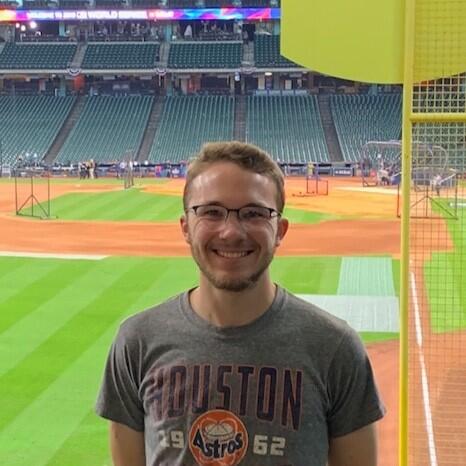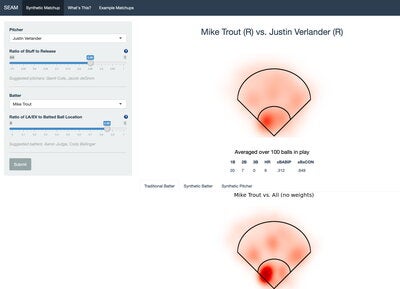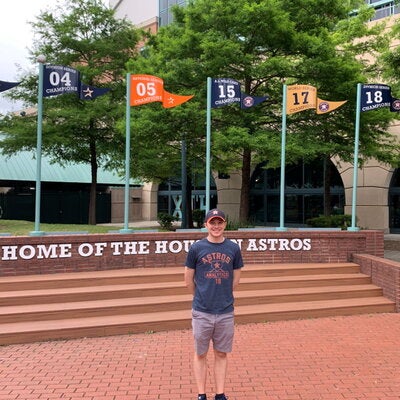
In the late hours of November 2, 2016, the Chicago Cubs clinched their first World Series win since 1908, a defining moment for any Chicago Cubs fan. For new University of Illinois student Charlie Young, it would prove life changing. That moment sparked a greater interest in baseball analytics for Young beyond that of just a hobby. This interest would lead him to the Illini Baseball team and, after graduation this May, to the Houston Astros—2017 World Series champions—as a full-time Quantitative Developer for the team.
Originally from Naperville, IL, Young is a double major in CS+Astronomy and Statistics.
The University of Illinois, in association with the Big Ten Network, released an insightful documentary titled “Runs and Data: The Science of Illinois Baseball” in early May 2020 that focused on Young’s trajectory of working with University of Illinois Professor Alan M. Nathan of the Physics Department and the Illinois Baseball team on developing the team’s analytics system. Young recently developed his own team of baseball analysts who will continue his work with the Illinois Baseball team after he graduates. Young has brought together a small handful of students from various backgrounds to combine a fully functioning analytics group that covers data acquisition, data cleaning, data storage, report generation, and presentation.
In early 2019, Young put out a call to bring together committed undergraduates to work for the Illini Baseball team as he began to prepare for his departure from the program. After narrowing down the applications to six students to join his team, Young began to teach them the fundamentals of statistical computing and graphics with R and showing them the progress he had made the prior two years with the Illini baseball team. The group evolved to include a scouting group, a player development group, and a player strategy group. Each group contributes their own pieces to the overall puzzle of baseball analytics.

“Charlie has been working tirelessly to train the next generation of Illini Baseball analysts. I’ve seen what those students can do already after he’s worked with them for less than a year. Based on that alone, he should have a standing offer to come back and teach whenever he’d like,” said Dr. David Dalpiaz, Teaching Assistant Professor of Statistics. Dalpiaz, along with Statistics Assistant Professor Daniel Eck have been working with Young on developing the SEAM (Synthetic Estimated Average Matchup) app, which allows users to statistically visualize Major League Baseball batter-pitcher matchups over the last five years.
Young credits Dalpiaz for his introduction to statistics through his STAT 400: Statistics and Probability I course. “Taking STAT 400 with David was the driving force in me declaring my statistics major—his enthusiasm for statistics elevated my learning and made that class one of my favorites in college,” Young said of Dalpiaz.
Dalpiaz, though, was not the only instrumental Statistics instructor who helped put Young on his path to success. James Balamuta, a Teaching Assistant for Statistics who developed STAT 385: Statistics Programming Methods, introduced Young to R, the programming language and software environment for statistical computing. “Learning the R syntax and a variety of R packages gave me a solid toolset that I put straight to work with the Illinois team. Like David, [Balamuta]’s commitment to educating and helping students advanced my learning and assisted me in applying what I was learning to outside projects. I can say without those two classes, and specifically those two professors, I would not be where I am today,” Young said of both Dalpiaz and Balamuta.
Young started working with MLB teams in 2017, when he began his first internship with the Cincinnati Reds as a Baseball Operations Consultant. While there, he wrote scripts to scrape data from various websites and match it with existing player entries. In 2018, he began working with the Baltimore Orioles as a Software Development and Analytics Consultant, where he continued to cull data along with the Director of Analytics and other lead developers to address key elements of their internal website. Then, what began as a research and development internship with the Houston Astros in June 2019, led to a Quantitative Developer position with the team where Young will continue working with the team in a full-time capacity after earning his degree this spring.
“These last few years have seen some of the best baseball teams in recent memory, starting with that 2016 Chicago team. That magical postseason run and victory parade cemented my future plans to work in baseball,” Young said. “It also was extremely interesting that both the Chicago and Houston teams were completely rebuilt in the mid-2010’s, which involved a tremendous amount of front office savvy and analytical ability. Those two things made it seem like this career path was something both interesting and rewarding, and I can’t wait to get down to Houston to join one of the best organizations in the league.”

“The Astros pride themselves on player development and evaluation, and I hope to contribute to that in any way I can,” Young said when asked about what it is he hopes to bring to Houston with him from Illinois. “Building applications and reports for the Illini team has fine-tuned my data presentation skills, so when I start my job as a Quantitative Developer I can help build applications that effectively communicate our ideas from Research and Development to the coaching staff.” Young also added, “Being able to run the entire process, from data collection to presenting to coaching staff, gave me such a unique set of skills that will definitely transfer to my job in Houston. As an analyst, my job is to work with data to help make important decisions—a large portion of that is the ability to effectively present results, and working with the team let me practice that skill almost every day.”
The ‘”Runs and Data: The Science of Illinois Baseball” documentary premiered on May 4, 2020, on the Big Ten Network and was produced by Tim Hartin, Kaitlin Southworth, and Alison Davis Wood of the Illinois News Bureau. “Kaitlin and her team did a phenomenal job working with me, Alan, and the team to show how much passion we have, not only for analytics, but for the game of baseball,” Young said. “Hopefully this documentary shows that college programs can benefit from analytics, and students can get involved to truly make a difference in their program.” Young also noted that it was a privilege to work with the documentary crew on highlighting the work he, Professor Nathan, the coaches and players of the Illinois Baseball team put into the science and understanding of baseball analytics.
Young will be able to carry his documentary with him to look back fondly on his time at the University with his mentor, Professor Alan Nathan. “Throughout the last few years, Alan and I have become lifelong friends, and our weekly meetings will be some of my best memories from college,” Young said of his mentor. Professor Nathan will continue as a Professor Emeritus with the Department of Physics as he further expands his research into the physics of bat-ball collisions.
Judging from previous interviews, from the LAS-Insider to A Few Minutes with Charlie Young audio interview, and this interview with the Statistics @ Illinois news group, it is clear to tell that Young is a driven and hardworking individual clearly focused on the future. With some parting advice, Young offered this: “If I could give one piece of advice to students struggling with focus or motivation, it would be to write things down. Over the course of my undergraduate years, I would find that when I felt unmotivated, it was usually because I had too many things to do and too many things in my head. Simply getting out a piece of paper and jotting everything down took all the ideas in my head and emptied them onto the paper. This accomplishes two things: it clears your head to allow for more focused thinking, and lets you see exactly what you have to do. Hopefully by doing this you can identify easy tasks that by completing, you start the ball rolling and give yourself motivation to do other tasks.”